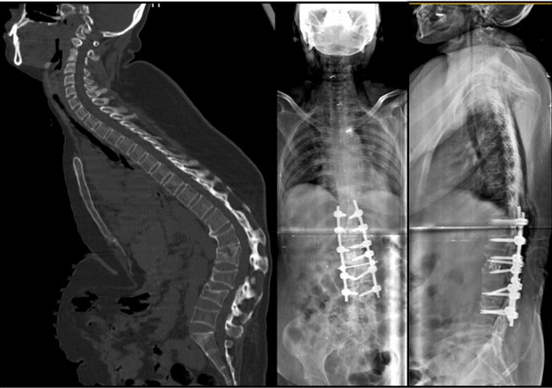kyphosis Correction Surgery
- Home
- kyphosis Correction Surgery
kyphosis Correction Surgery
What is Kyphosis (Roundback) of the Spine?
Some degree of rounded curvature of the spine is normal. The term kyphosis is used to describe the spinal curve that results in an abnormally rounded back.

A ten-year-old girl with Scheurmann's kyphosis
What are the causes of kyphosis?
There are different causes of kyphosis.
Congenital – due to developmental abnormalities of the vertebral column by birth. In some infants, the spinal column does not develop properly while the fetus is still in the womb. The bones may not form as they should. Several vertebrae may be fused together. Either of these abnormal situations may cause progressive kyphosis as the child grows. Surgical treatment may be needed at a very young age. Surgery can help maintain a more normal spinal curve. Consistent follow-up is required to monitor any changes.
Post-infective – following tuberculous destruction of the front part of the spine.
Post-traumatic – due to damage to the vertebral body in an injury.
Post-laminectomy – following previous decompression surgery performed in childhood.
Scheurmann’s kyphosis – disease that leads to anterior wedging of vertebral bodies. Scheuermann’s kyphosis often becomes apparent during the teen years; however, patients with Scheuermann’s kyphosis have a significantly more severe deformity, particularly in thin individuals. Scheuermann’s kyphosis usually affects the upper (thoracic) spine. It can also occur in the lower (lumbar) back area. If pain is present, it is usually felt at the apex of the curve. Activity can aggravate the pain, as can long periods of standing or sitting. Exercise and anti-inflammatory medication can help ease associated discomfort.
Postural kyphosis is the most common type of kyphosis. It is often attributed to slouching. It represents an exaggerated, but flexible, increase of the natural curve of the spine. Postural kyphosis usually becomes noticeable during adolescence. It is more common among girls than boys. It rarely causes pain. Although exercise to strengthen the abdomen and stretch the hamstrings may help relieve associated discomfort, it is unlikely to result in significant correction of the postural kyphosis. With occasional exceptions, postural kyphosis does not lead to problems in adult life.
How is kyphosis diagnosed?
The patient is brought to the doctor by a child’s or parent’s concern about the cosmetic deformity of a rounded back, or pain. The doctor may ask the child to bend forward so that the slope of the spine can be assessed. X-rays of the spine will show if there are any bony abnormalities. X-rays will also help measure the degree of the kyphotic curve. A kyphotic curve that is more than 50° is considered abnormal

On bending forward, the deformity of the back worsens significantly
Treatment will depend on the reason for the deformity. Most teens with postural kyphosis will do well throughout life. An initial program of conservative treatment that includes exercises and anti-inflammatory medications (for discomfort) is recommended for patients with Scheuermann’s kyphosis. If the patient is still growing, the doctor may prescribe a brace. The patient typically wears the brace until skeletal maturity is reached. Surgery may be recommended if the kyphotic curve exceeds 750. Patients with congenital kyphosis, post-tubercular, post-laminectomy and post-traumatic kyphosis will need early surgery to prevent neurological complications.

A patient with complex post-traumatic kyphosis treated by osteotomy and stabilization.
Surgical Expertise
Testimonials
What Our Patients Say
EXCELLENT rating
Based on 107 reviews My father had rotator cuff problems and needed follow-up care.Dr.Ankith N V was exceptional. They provided thorough, compassionate care and clear communication. The clinic was well-equipped, and attentive Highly recommend.
My father had rotator cuff problems and needed follow-up care.Dr.Ankith N V was exceptional. They provided thorough, compassionate care and clear communication. The clinic was well-equipped, and attentive Highly recommend. RAVINDRA KUMAR2024-06-09Very good Orthopaedic Clinic and Dr Ankith sir well experienced Dr and also clear all the doubts for patients and their families...
RAVINDRA KUMAR2024-06-09Very good Orthopaedic Clinic and Dr Ankith sir well experienced Dr and also clear all the doubts for patients and their families... Dilip Gowda BR2024-05-29I had an outstanding experience with Dr. Ankit at Ankit’s Orthopedic . Dr. Ankit’s exceptional friendliness and professionalism made me feel comfortable and well-cared for throughout my visit. I highly recommend Dr. Ankit for their exemplary patient care and welcoming demeanor.
Dilip Gowda BR2024-05-29I had an outstanding experience with Dr. Ankit at Ankit’s Orthopedic . Dr. Ankit’s exceptional friendliness and professionalism made me feel comfortable and well-cared for throughout my visit. I highly recommend Dr. Ankit for their exemplary patient care and welcoming demeanor. Nikhil L2024-05-29Doctor is so knowledgeable and humble. Also he listens to us keenly and understands the problem. Highly recommended.
Nikhil L2024-05-29Doctor is so knowledgeable and humble. Also he listens to us keenly and understands the problem. Highly recommended. Akshay2024-05-29Good communicate with patients and cooperation well good, we are satisfied your treatment.
Akshay2024-05-29Good communicate with patients and cooperation well good, we are satisfied your treatment. renuka Mallikarjuna2024-05-22Best orthopaedic clinic in vijayanagar good service
renuka Mallikarjuna2024-05-22Best orthopaedic clinic in vijayanagar good service ಬಳ್ಳಾರಿ ನಾಗ2024-05-22Very good doctor and
ಬಳ್ಳಾರಿ ನಾಗ2024-05-22Very good doctor and Kiran S2024-05-18Really...this clinic is too good i recommended Dr.Ankith sir ..and doctor treat very well, he had more knowledge and as well as good human being and his staff is wonderful, this is the perfect place for orthopedic and spine
Kiran S2024-05-18Really...this clinic is too good i recommended Dr.Ankith sir ..and doctor treat very well, he had more knowledge and as well as good human being and his staff is wonderful, this is the perfect place for orthopedic and spine ashoka vc2024-05-17Good service well qualified doctor
ashoka vc2024-05-17Good service well qualified doctor srinath v2024-05-17
srinath v2024-05-17
Book Your Appointment Today!
Call us at 099644 83761 to schedule your visit. Your path to recovery begins at Dr. Ankith’s Orthopedic & Spine Care Clinic. We look forward to helping you achieve your health goals!
